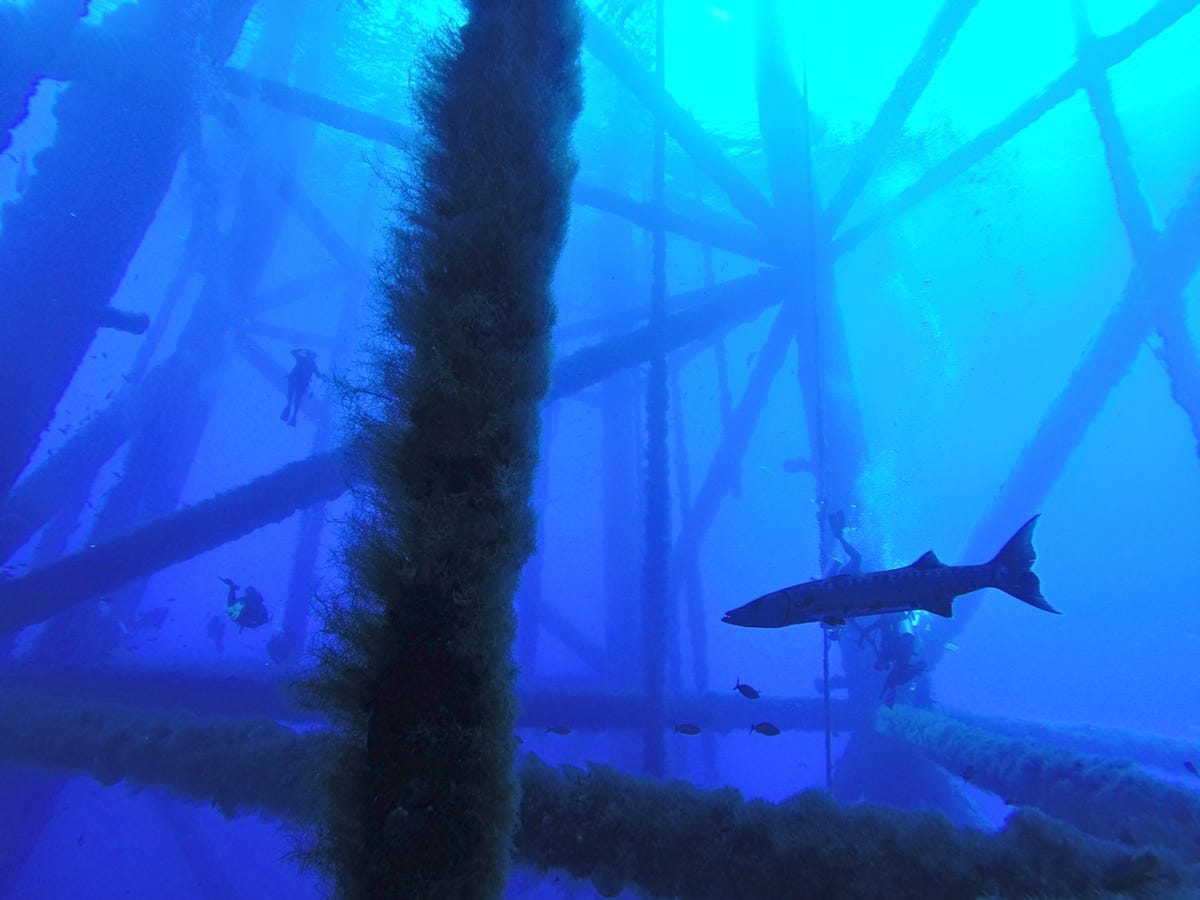In the Gulf of Mexico, from oil rigs to fish havens (pictures)
All around the Gulf, old oil rigs have been transformed into marine habitats. CNET Road Trip 2014 dives deep under the surface to check out the Rigs to Reefs program.

Barracuda and the reef
FLOWER GARDEN BANKS, GULF OF MEXICO -- Ever wondered what happens to an oil rig when it's no longer producing? Since 1990, 450 in the Gulf of Mexico have been transformed into artificial reefs as part of a series of state-run programs known as Rigs to Reefs.
Thanks to the programs, which are run in Texas, Mississippi, Alabama, Louisiana, and Florida, the oil companies donate the rigs rather than tow them back to shore, and also donate half their cost savings.
As part of CNET Road Trip 2014, I traveled more than 100 miles into the Gulf to check out one of the rigs -- technically known as a production platform -- from 100 feet below the surface, where thousands of fish, including this barracuda, have a comfortable home.
Please click here for my full story on the Rigs to Reefs program.
Looking up to the top
Most of the decommissioned rigs have their platforms severed, and only begin at 85 feet below the surface. This rig, technically known as a production platform, is the High Island 389. Owned by W&T Offshote, it's under consideration for donation to the Texas Rigs to Reefs program. As of today, it has not had its platform severed but it is considered officially idle.
High Island 389
High Island 389, seen from the surface of the Gulf of Mexico.
Tons of fish
It's estimated that each of the artificial reefs in the program can be home to between 12,000 and 14,000 fish. The High Island 389, while not yet part of the program, is already home to teeming marine life.
Divers investigating
The Rigs to Reefs program creates new habitats for marine life and also offers new opportunities for fishing and scuba diving.
Selfie
CNET reporter Daniel Terdiman waves hello in a selfie taken within the perimeter of High Island 389.
Fish at the rig
Many species of fish call High Island 389 their home. It's not yet clear what will happen to the oil rig, which is currently "idle," according to W&T Offshore, the company that owns it.
Barracuda
A barracuda swims within a decommissioned oil rig in this official Texas Rigs to Reefs program photo.
French Angel
A fish known as a French Angel calls this decommissioned oil rig -- not High Island 389 -- home.
Spotfin Butterfly
Another species of fish that calls the Gulf of Mexico, and this decommissioned oil rig, home is the Spotfin Butterfly
Spanish Hogfish
A number of Spanish Hogfish brighten the area inside this decommissioned oil rig.
Spadefish
The Spadefish is plentiful within the confines of this decommissioned oil rig.
Something's fishy
Looking up toward the top of the High Island 389, you'll see hundreds, if not thousands, of fish.
Fish down below
The average decommissioned oil rig has piles -- legs -- that go down 200 feet or more below the surface. The High Island 389, which is not yet part of the Rigs to Reefs program, goes down 300 feet, and fish can be found all the way down -- though most of those depths are below the range of recreational scuba divers.
Fish and a joint
A major joint in the High Island 389 platform is teeming with fish.
Fish and a beam
This beam, part of the High Island 389 production platform, is covered in marine life.
High Island 389 from afar
The High Island 389 disappears into the distance.
Growth on a beam
Marine life is abundant within the perimeter of the High Island 389.
More fish down below
Teeming marine life in the depths of the High Island 389 production platform.
Looking straight up
A look straight up at the underside of the main part of a production platform in the Gulf of Mexico.

